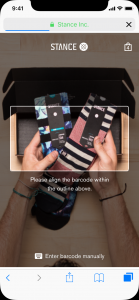The payments industry’s drive to bypass—or eliminate—the traditional retail checkout typically involves a mobile app, but on Thursday Moltin, a 5-year-old Boston-based developer, introduced a browser-based self-checkout capability that lets customers ring up their own goods. The first merchant to deploy the technology is a San Clemente, Calif.-based clothing maker and retailer called Stance.
In related news, Amazon.com Inc. has leased space at two locations in Chicago for Amazon Go stores, according to a report Thursday in the Chicago Tribune. The Chicago stores are among the initial indications of the checkout-free Amazon Go concept’s expansion beyond the first location in Seattle, Amazon’s home city. Amazon said last month it would also open an Amazon Go store in San Francisco.

With the Moltin technology, which relies on an application programming interface linking to the merchant’s servers, a shopper using a smart phone can find a short URL, scan the barcode attached to the products, and make payment with a digital card or with Apple Pay or Google Pay. In this way, consumers can avoid downloading an app to check out and can make an in-store purchase in much the same way they would in an e-commerce scenario, Moltin says.
At the Stance stores, customers as they walk out must show a receipt on their phone screen, which greeters at the door compare to the items customers have in their bags.
“We are really excited to be at the forefront of the retail experience by offering a truly hassle-free self-checkout experience in our stores,” said Paul Zaengle, executive vice president of direct to consumer at Stance, in a statement. “People don’t want to wait in line, and they don’t want to download an app to avoid a line either.” A maker and seller of a wide variety of socks and other clothing items, Stance has installed the Moltin capability at three stores so far and plans to add it in six stores that are expected to open by the end of the year.
Moltin says its APIs can link to merchants’ established catalogs, payment gateways, and point-of-sale systems. In Stance’s case, the technology is connected to its POS system and with its Stripe integration, according to Moltin.
In the case of the Amazon Go convenience store, which does away with traditional checkouts by tracking customers as they pick up items and charging their stored card credentials as they leave, the upcoming Chicago and San Francisco locations represent expansion of a concept that Amazon only recently made available to the public after months of testing with Amazon employees.
The Chicago stores will be situated in an office building connected to the Ogilvie Transportation Center, one of two major commuter-train stations in the city, and in Willis Tower (formerly known as Sears Tower), Chicago’s tallest building, according to the Tribune. San Francisco’s store will be located in the city’s Union Square, according to the San Francisco Chronicle.
Both the Moltin APIs and Amazon Go are part of a trend toward easing shopping and payments in physical stores by eliminating hassle, or friction, as much as possible. But the idea, while seemingly logical, may take some time to win over consumers. In the case of Amazon Go, for example, just 11% of consumers said they’d “definitely shop this way” if a local store offered it, according to survey results released this week by Paysafe Group, which canvassed more than 5,000 consumers in the United States and four other countries. The other 89% expressed concerns about security and privacy, said they didn’t know enough about it, or said they “can’t see the point.”





